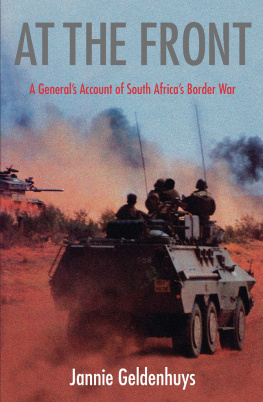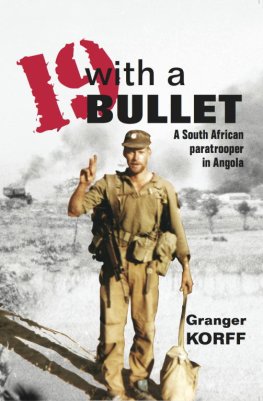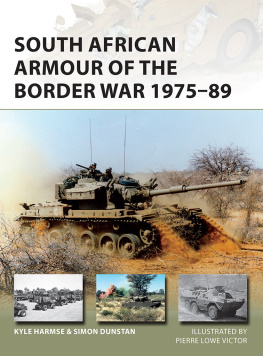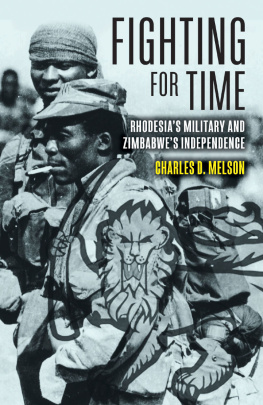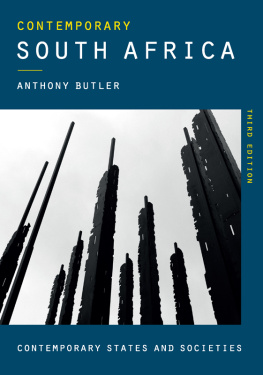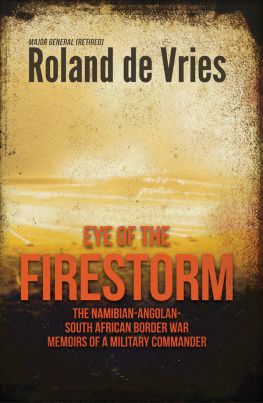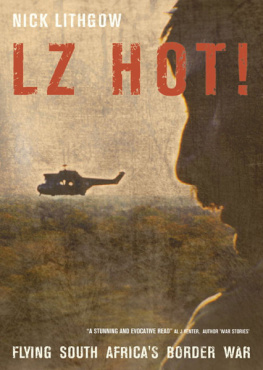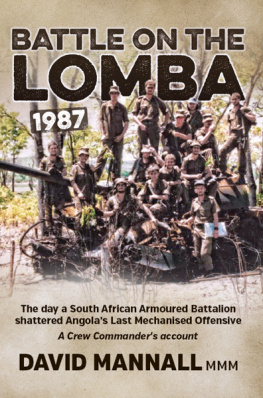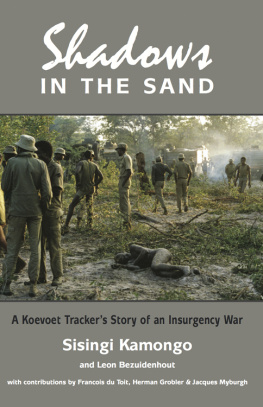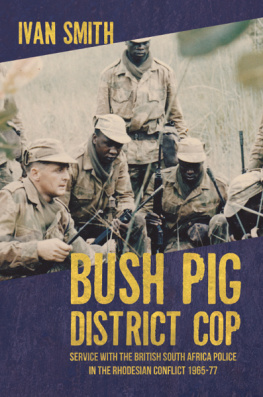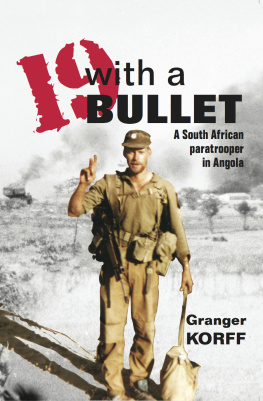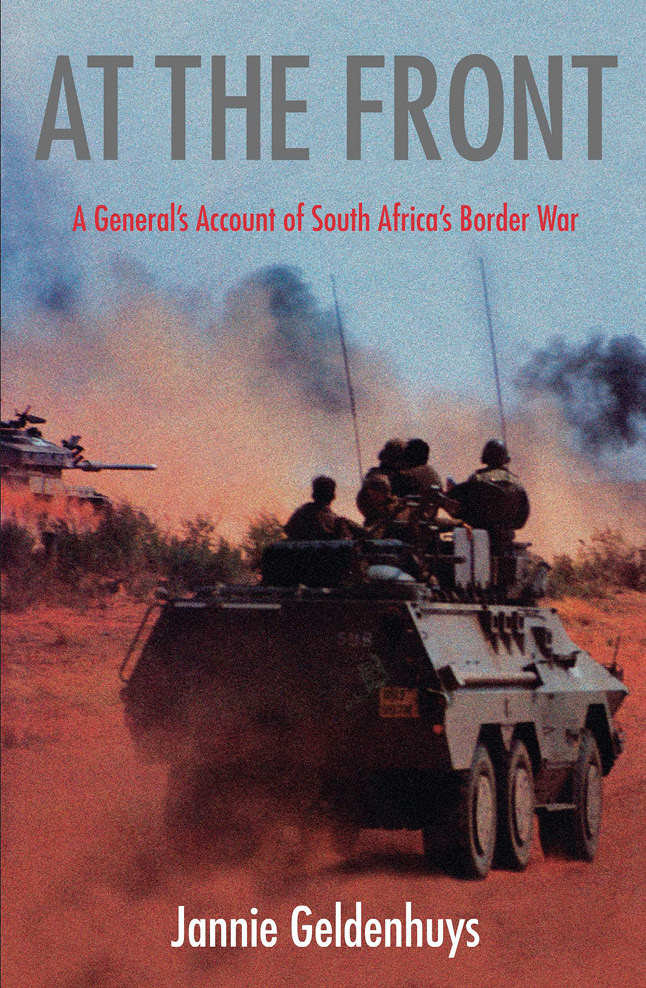
Description
General Jannie Geldenhuys is widely regarded as one of the leading military commanders South Africa has produced. As Chief of the South African Defence Force from 1985 to 1990, he brought his experience to bear on the Border War in Namibia, and was part of the negotiating team that brought an end to the conflict in 1989. In this completely revised and updated edition, Geldenhuys reflects on a military career spanning more than four decades. At the Front covers the years before and during the protracted Border War, and consists of Geldenhuys personal experiences and insights. He sheds light on the final years of the conflict and the negotiated settlement, and also writes of his early years, as he evolved from a rugby-mad young officer to a deep-thinking, reflective man with ever-sharpening insights into war, peace, politics and, most of all, himself.
Title Page
AT THE FRONT
A Generals Account of South Africas Border War
Jannie Geldenhuys
JONATHAN BALL PUBLISHERS
JOHANNESBURG & CAPE TOWN
Preface to the Second English-Language Edition
PREFACE TO THE SECOND ENGLISH-LANGUAGE EDITION
When I first wrote this book, between December 1990 and January 1992, I did not set out to research and produce a history. Instead I committed to paper an account of what I had experienced. The book was published in Afrikaans in 1993, entitled Di wat wen n generaal se storie uit n era van oorlog en vrede , followed in 1994 by the English version, A generals story from an era of war and peace .
It was an uncomfortable time to write a story like this, because on 2 February 1990 South Africa had taken a quantum leap into the future, and in the weeks and months that followed the situation and the thinking changed faster than in all the previous years and decades.
I have not modified that original story for this edition in any substantial way. Changes relate mainly to structure rather than content, although here and there are minor explanatory additions for the benefit of a newer and wider potential audience, a few small corrections have been made and I have added a final chapter.
But it remains what it was: a story about life. A story about people, about friends and enemies: people who opened up the way ahead and people who went down that new path; about great people who turned out to be small, and small people who turned out to be great.
* * *
There are people who would like secretly to think that we were beaten on the battlefield during what is now popularly called the bush war. Even at this latest time of writing, 2007, they are still fossicking about in the embers of a war which is now past and long since burnt out. They hunt for defeats and hidden misdeeds by the winners, and look for angels and forgotten glories on the side of the losers.
They are a pathetic sight in their suits of sackcloth and ashes. The last shoot-outs of the Cold War ended in 1988 two decades ago. It is time for everyone to accept the facts.
The global Cold War was an intertwined conglomeration of politics, propaganda campaigns and warfare. In southern Africa the shooting war ended in 1988 with a wave of Cuban defeats in the Angolan bushlands. And in Europe, hot on the heels of these events at our back door, the political war ended with the collapse of the Berlin Wall and the disintegration of the Soviet Union.
Fables
A couple of decades after the fact, one wishful thinker after another, in books, newspapers, magazines and radio and TV programmes, is engaged in revealing alleged secrets and intrigues which belong in the realm of fables. They claim that we lost the bush war against the Cubans, and that we left behind great numbers of South African soldiers and combat aviators in shallow graves, and concealed mass burial sites of our victims near the erstwhile border base of Eenhana in Namibia All ancient and nonsensical propaganda stunts which are being dished up for a new audience.
Facts
No nation, and that includes the Cubans, would tolerate the execution by firing-squad of its best army general (General Arnaldo Ochoa Sanchez) just after the bush war, especially not when the general commanding their air force had just fled to Miami, Florida.
It is common knowledge that if more than 40 South African combat aircraft had been shot down in Angola, aircrew and all, and more than 1 000 troops killed as was alleged in the Beeld newspaper the voting public would have rebelled, and the then South African government would have fallen. (Incidentally, it is a delicate matter to talk lightly of casualties, and in a radio interview I requested that we wait for the reaction of the next of kin of all the dead who were supposed to be buried in shallow graves in Angola to discover the truth. There was no reaction to this suggestion, although the accusations continue.)
The mass graves in Namibia were, ironically enough, the tragic consequence of the United Nations peace-keepers dereliction of duty at the end of the bush war. They were supposed to protect the cease-fire agreement from insurgent infiltrators. They did not, despite the fact that we gave them early warning of what was happening!
So at the beginning of April 1989, there was another outburst of fighting, the so-called Nine-Day War, when a large number of SWAPO infiltrators contravened the cease-fire agreement and in the process suffered heavy losses the result being the mass graves at Eenhana. The South African police and air force helicopters saved the situation. The dead insurgents were buried under UN control and in full view of the media and the public. There was nothing secret about it, and if it was denied (as the media allege) by someone like Martti Ahtisaari, the former Special Representative of the UN Secretary-General, he was either playing very recklessly with the truth or simply telling ordinary blatant lies.
It is ironic that in 2007 one must still rely on an unamended manuscript of yesterdays events to find the bracing truth behind todays panel-beaten lies. The first-hand eyewitness truth is available, and I am very proud of the fact that the first edition of this book remains one of the best original sources of truth about the war.
It is also highly regarded by Dr Chester Crocker, United States Deputy Secretary of Foreign Affairs for Africa, who was the neutral facilitator of the final negotiations between the Republic of South Africa, the USSR, Cuba and Angola. Crocker calls it the work of a professionals professional.
The political situation
I retired as Chief of the South African Defence Force on 31 October 1990, just after the end of the Cold War. My book contains my life-story, but it is especially a personal witnessing of South Africas experience of the Cold War between 1970 and 1990. I participated in that war in key positions of leadership, authority and responsibility, from the beginning to the end.
One of the Cold Wars great episodes was the story of South West Africas constitutional development to independence. From my perspective the United Nations and its stubborn, muddle-witted commissioner, Sean McBride, played no significant early role; much later, the single greatest and unnecessary mass killing of the entire story took place on 1 April 1989 as a result of the dereliction of its much-vaunted Special Representative, Martti Ahtisaari.
It is true that the Western Big Five (the USA, Canada, the United Kingdom, France and Germany) achieved some breakthroughs at first, but later their wilfulness caused a 10-year delay in South West Africas international constitutional development.
SWAPO, the South West African Peoples Organisation, made its external contribution to independence, but its then leader, Sam Nujoma, is still suspected along with Ahtisaari of complicity in the deaths caused by his organisations violation of the ceasefire in April 1988.
Next page
